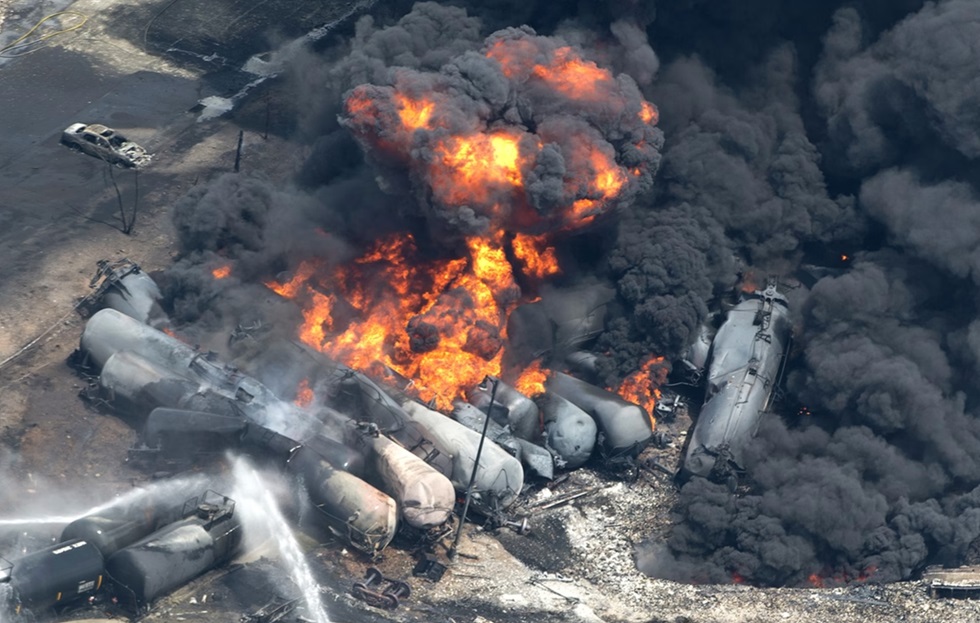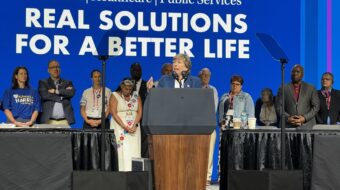
WASHINGTON —Fed up with the big Class I freight railroads’ incessant drive to put profits over people, and safety, and with federal regulators’ piecemeal and often pro-corporate responses, a coalition of rail freight unions issued a comprehensive analysis of the problem, with key recommendations to the government to force the carriers to put people first.
The study, including pages of internal railroad documents and e-mails, reveals the horrible impacts of the railroads’ system, Precision Scheduled Railroading (PSR). It’s designed to cut costs and workers, including safety workers who inspect freight cars and locomotives.
Key recommendations include having the federal government impose uniform training requirements, industry-wide, and minimum staffing requirements for the overall number of workers needed to inspect and certify the safety of locomotives and freight cars.
PSR means the safety problems start even before workers join a big rail freight firm, the analysis reveals, with a lack of uniform standards for training workers on inspections.
The Federal Railroad Administration should “work in conjunction with the Surface Transportation Board to establish and implement an adequacy of workforce standard that ensures the Class I freight railroads always maintain an appropriate amount of highly skilled, qualified, and certified employees,” the analysis says.
One big Class I freight railroad, CSX, worked with the feds to do that, the analysis notes. The two federal freight rail regulators should implement that standard on the others, it advocates.
“After all, having a model training program with the best standards for an entire industry means absolutely nothing if you do not have an adequate workforce to perform the critical work the training is based upon.”
And while PSR now pushes railroads to get middle managers to order workers to cut corners on safety, the report notes current federal rules ban such pressure. Any managers found doing that should be fired. Enforce that firing rule, the analysis adds.
PSR also lets the big rail freight firms create longer—and thus more profitable and often more dangerous–trains, delay and defer needed maintenance, and drive the resulting increased profits into pockets of freight rail execs and their Wall Street financial backers.
The cost has been at the expense of workers and safety. The freight railroads cut 41% of their maintenance workers starting in 2015. Communities have suffered close calls and derailments. Workers and sometimes town residents have been injured or killed.
As a result of PSR, the freight rail industry “is on the precipice of disaster,” the analysis says.
The report does not cite specific accidents and crashes to back up its points. But the unions and Railroad Workers United, the rank-and-file workers group whose members come from all 14 rail crafts, can cite two of the worst accidents bracketing the last 11 years to do so. The first was at Lac Megantic, Quebec. The second was at East Palestine, Ohio, almost a year ago.
The Lac Megantic oil train derailment, crash, and explosion involved a small Canadian railroad, not a Class I freight, but the result was a catastrophe: The small town’s downtown was wiped out by the fire and 47 people died. PSR principles—in this case, running the train with only an engineer—were one cause.

No second worker
There was no second worker to stop the parked train from rolling downhill, at increasing speed, after its brakes failed while the engineer was on a break. It jumped the track on a curve.
The East Palestine, Ohio, crash, involving a mile-and-a-half-long Norfolk Southern freight train, sent a mushroom-style cloud over the town, forced its evacuation, produced a toxic chemical spill that killed thousands of fish, and poisoned the air and groundwater. And 39 Brotherhood of Maintenance of the Way/Teamsters members sent to clean up the mess got sick.
Union Pacific is a particular offender against safety, the analysis says. Its new CEO, Jim Vena, imposed on UP by a hedge fund, “is a staunch PSR supporter” and federal inspections of UP’s freight cars and locomotives reflect a lack of maintenance: “Federal defects” in 19.93% of freight cars and 72.69% of locomotives.
“There has been no sense of urgency by Union Pacific to address locomotive and car defects.
Sen. Tammy Duckworth, D-Ill., brought up that “precipice of disaster,” though she didn’t use those words, during congressional hearings on East Palestine. It’s a small town with one freight rail track, she noted. Duckworth is from Chicago, a city of 2.6 million and the nation’s freight rail hub. It has 3,685 miles of track, much of it through highly industrialized areas, and hosts thousands of freight trains a day.
Duckworth didn’t have to spell out what would happen if an East Palestine-like crash occurred on Chicago’s Southwest Side, where freight rail tracks pass oil tanks and other heavy industry.
The unions want the two agencies to move because rail industry lobbying and campaign contributions, overwhelmingly to Republican pro-corporate lawmakers, have stymied congressional efforts to force railroads to change their priorities and put people before profits.
Unions submitting the study to the federal Transportation Department all represent rail craft inspectors, mechanics, and similar safety-oriented workers: The Carmen Division, the Machinists, the Boilermakers, the Electrical Workers (IBEW), the Firemen And Oilers/SEIU, the Sheet Metal Workers, the Transportation Communications International Union, and the Transport Workers.
“The Class I freight railroad industry neither has nor provides a model training program that ensures every Shop Craft worker, and supervisor, completes adequate practical on-the-job, classroom and testing training, qualification, and certification under truly qualified supervision,” it says. Such training takes a minimum of three years, the analysis notes.
“Instead, each Class I freight railroad has their own training program carried out on an ad hoc basis, based on the railroads’ interpretation and application of federal regulations” and “provisions of collective bargaining agreements with the multiple shop craft unions. With the adoption of the PSR cost-cutting business model, the quality of training, safety, and performance has only deteriorated.”
Conditions went downhill from there, especially since both locomotives and freight cars need more frequent inspections as they age—and 55% of the Class I freights’ locomotives were built before 2000 and another 16% from 2000-2004. The locomotives have expected “lives” of 30 years or so.
But with fewer workers and inspectors, and the pressure to cut costs by cutting workers to increase profits, the result has been fewer inspections, hastier inspections, and supervisors pressuring workers to quickly inspect, and pass, freight cars and locomotives which should have been in the shop for repairs and equipment replacement.
We hope you appreciated this article. At People’s World, we believe news and information should be free and accessible to all, but we need your help. Our journalism is free of corporate influence and paywalls because we are totally reader-supported. Only you, our readers and supporters, make this possible. If you enjoy reading People’s World and the stories we bring you, please support our work by donating or becoming a monthly sustainer today. Thank you!












Comments